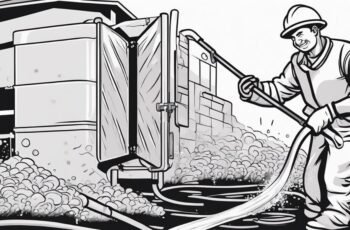Are you aware of the key factors that can help prolong the lifespan of your septic tank system?
Regular maintenance is crucial, but do you know which specific items should be on your checklist to ensure everything runs smoothly?
From scheduling routine pumping to monitoring water usage, there are essential tasks that every homeowner should prioritize to avoid costly repairs and potential health hazards.
Stay ahead of the game and safeguard your home by staying informed on the necessary steps to maintain your septic tank system.
Key Takeaways
- Adhere to a regular pumping schedule every 3 to 5 years to prevent backups and maintain efficiency.
- Practice proper waste disposal by avoiding non-biodegradable items and educating on responsible flushing habits.
- Conduct regular drainfield inspections to address issues promptly and ensure system longevity.
- Monitor water usage, fix leaks promptly, and consider water-saving appliances to prevent overloading the septic system.
Regular Pumping Schedule

To maintain the health and efficiency of your septic tank system, it's crucial to adhere to a regular pumping schedule. Regular pumping helps prevent solids from accumulating in the tank, which can lead to clogs, backups, and costly emergency repairs. A general rule of thumb is to have your septic tank pumped every 3 to 5 years, but this can vary based on household size, water usage, and tank size.
Maintenance tips for your septic tank include being mindful of what you flush down the drains. Avoid flushing non-biodegradable items, grease, oils, and chemicals as these can disrupt the natural processes happening in the tank. Additionally, conserve water to prevent overloading the system. Fix any leaky faucets or running toilets promptly to avoid unnecessary strain on the septic system.
Proper Waste Disposal Techniques
Implementing proper waste disposal techniques is essential for maintaining the health and longevity of your septic tank system. To ensure your septic tank functions optimally, consider eco-friendly alternatives like using biodegradable soaps and cleaners to reduce the impact of harsh chemicals on the system. Avoid flushing non-biodegradable items such as wet wipes, cotton balls, or hygiene products down the toilet to prevent clogs and potential damage to your septic tank and drainfield.
Community education plays a crucial role in promoting responsible waste disposal practices. By educating your household members and neighbors about the importance of proper waste disposal, you can help prevent septic system issues that may arise from improper use. Encouraging others to adopt environmentally friendly habits and participate in community initiatives for waste management can contribute to the overall health of your septic tank system and the environment.
Inspection of Drainfield Condition

Regular inspection of your drainfield condition is crucial for ensuring the proper functionality and longevity of your septic tank system.
Soil compaction and root intrusion are common issues that can impact the efficiency of your drainfield. To check for soil compaction, walk over the drainfield area and observe if the soil feels overly firm or saturated. Compacted soil can restrict the flow of wastewater and lead to backups in your system.
Additionally, keep an eye out for any signs of root intrusion, such as lush vegetation or actual roots near the drainfield. Roots can penetrate pipes and cause blockages, disrupting the proper operation of your septic system.
If you notice any of these issues during your inspection, it's essential to address them promptly to prevent more significant problems down the line.
Monitoring Water Usage
Monitoring water usage plays a vital role in maintaining the efficiency and longevity of your septic tank system. By keeping a close eye on your water consumption, you can prevent overloading the system and avoid potential issues that may arise from excessive water flow. Here are some key points to consider:
- Regularly Check for Leak Detection: Be proactive in inspecting your plumbing fixtures, pipes, and septic system for any signs of leaks. Addressing leaks promptly can prevent unnecessary strain on your septic tank.
- Practice Water Conservation: Implement water-saving habits such as fixing dripping faucets, using low-flow fixtures, and being mindful of excessive water use. Conserving water not only benefits the environment but also helps your septic system operate more efficiently.
- Monitor Your Water Meter: Keep track of your water meter readings to identify any sudden spikes in water usage. Unexplained increases could indicate a leak or a problem with your septic system.
- Consider Installing Water-Saving Appliances: Upgrading to energy-efficient appliances like dishwashers and washing machines can reduce water consumption, easing the load on your septic tank.
Frequently Asked Questions
What Are the Signs That Indicate a Septic Tank Is in Need of Repair or Replacement?
If you notice foul odors, slow drains, or soggy areas in your yard, these could be warning signs that your septic tank needs repair or replacement. Contact a professional for repair options and consider maintenance tips to avoid high replacement costs.
Are There Any Specific Cleaning Products or Additives That Should Be Avoided to Prevent Damage to the Septic System?
When it comes to maintaining your septic system, steer clear of harmful additives and chemicals. Stick to safe cleaning products to prevent damage and take preventative measures to ensure your system stays in top shape.
How Can Homeowners Prevent Roots From Invading and Causing Damage to Their Septic System?
To prevent roots from invading your septic system, regularly inspect and maintain it. Avoid planting trees or shrubs near the tank or drainage field. Trim existing greenery to keep roots at bay. Consider root barriers for added protection.
What Steps Should Be Taken in the Event of a Septic System Backup or Overflow?
In the event of a septic system backup or overflow, act promptly. Take immediate emergency response steps to prevent further damage. Contact professional assistance for thorough inspection and repair. Explore DIY options cautiously.
Are There Any Regulations or Permits Required for Septic System Maintenance or Repairs in Certain Areas?
In certain areas, septic system maintenance or repairs may require permit requirements to ensure regulatory compliance. It's essential to check with local authorities to understand any necessary permits before starting any work.
Conclusion
Overall, maintaining your septic tank is crucial for the health of your home and the environment. By following a regular pumping schedule, properly disposing of waste, inspecting the drainfield, and monitoring water usage, you can prevent costly repairs and ensure your septic system functions properly.
For example, imagine a homeowner who neglected septic tank maintenance and ended up with a sewage backup in their yard, causing extensive damage and requiring expensive repairs.
Don't let this happen to you – stay on top of your septic tank maintenance checklist!

